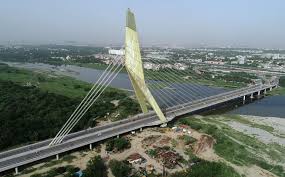1. Andhra Pradesh’s ‘Temple Run’ Flyover (Venkatreddy Palle)
Located near Vasudevapuram on State Highway 57, this flyover gained notoriety for its three sharp 90-degree turns, drawing comparisons to Bhopal’s infamous bridge. Shared widely on social media, with Congress Kerala’s X post mockingly stating, “Bhopal made a 90° flyover. Andhra: ‘Hold my chai,’” the structure baffled commuters and engineers alike. Critics labeled it a “Temple Run” highway, likening its zigzagging path to the twists of a video game. The design, attributed to land constraints, sparked concerns about accident risks, especially for heavy vehicles. Authorities have yet to announce redesign plans, but the flyover’s viral fame has fueled calls for stricter oversight in infrastructure planning.

2. Subhash Nagar’s ‘Snake-Like’ Bridge (Bhopal)
Just weeks after Bhopal’s Aishbagh bridge controversy, the Subhash Nagar Railway Over Bridge (ROB), operational for two years, came under scrutiny for its serpentine design and poorly placed dividers. Costing ₹40 crore, the bridge connects Maida Mill to Prabhat Petrol Pump but reported two accidents within eight hours due to its sharp curves. Structural engineer Prakhar Pagaria criticized such designs as inherently risky unless unavoidable, urging better oversight. Social media users dubbed it a “snake-like” structure, questioning why safety was compromised despite its aim to ease congestion for commuters heading to Bhopal Railway Station.
3. Mumbai’s Misaligned Overbridge (Andheri)
In 2023, a railway overbridge in Mumbai’s Andheri suburb became a national embarrassment when its two sections, built by separate agencies, missed connecting by six feet. Intended to ease traffic between Andheri East and West, the misalignment was discovered during final inspections, delaying the project and sparking public outrage. Social media posts lampooned the error, with one user joking, “Did they forget to use a ruler?” The incident, reported by The Times, highlighted coordination failures between the Mumbai Metropolitan Region Development Authority and the Railways, requiring costly corrections and fueling distrust in urban planning.
4. Bihar’s Collapsing Ganges Bridge (Bhagalpur)
In 2023, a bridge under construction over the Ganges in Bhagalpur, Bihar, collapsed before its ninth completion deadline, raising questions about engineering competence and corruption. Costing ₹1,710 crore, the project was meant to connect Bhagalpur and Khagaria but faced repeated delays due to design flaws and contractor disputes. Videos of the collapse went viral, with X users calling it a “monument to mismanagement.” An official inquiry cited poor quality control, leading to the blacklisting of the construction firm. The incident underscored systemic issues in Bihar’s infrastructure projects.
5. Delhi’s Signature Bridge Missteps
Inaugurated in 2018, Delhi’s Signature Bridge over the Yamuna River faced criticism for its wobbly structure during high winds, alarming commuters. Costing ₹1,594 crore, the cable-stayed bridge was hailed as a tourism landmark but drew flak for inadequate wind resistance testing. Social media users shared videos of the bridge swaying, with one commenting, “Looks like a thrill ride, not a road.” Engineers later reinforced the structure, but the controversy highlighted rushed planning in high-profile projects. The bridge remains a polarizing symbol of ambition versus practicality.
6. Chennai’s Flood-Prone Flyover (Kathipara)
The Kathipara Flyover in Chennai, one of India’s largest cloverleaf interchanges, was designed to streamline traffic but became infamous for severe waterlogging during monsoons. Built at a cost of ₹450 crore, the flyover’s poor drainage system led to vehicles wading through knee-deep water, stranding commuters for hours. Social media posts showed cars floating, with captions like “Chennai’s new aquatic highway.” Despite repeated promises of retrofitting, the issue persists, exposing flaws in urban infrastructure planning in flood-prone cities.
7. Kolkata’s Curved Flyover (Maa Flyover)
Kolkata’s Maa Flyover, extended in 2015 to ease traffic, features an unusually tight curve near Park Circus that has caused multiple accidents. The ₹500-crore structure’s sharp bend, attributed to land acquisition issues, confused drivers navigating at moderate speeds. X users shared images of crashed vehicles, with one quipping, “This flyover is a geometry exam nobody asked for.” The Kolkata Metropolitan Development Authority promised speed breakers and signage, but critics argue the design flaw demands a complete overhaul to ensure safety.
Lessons from the Blunders
These examples, like Bhopal’s 90-degree flyover and Indore’s Z-shaped bridge, reflect recurring challenges in India’s infrastructure development: land scarcity, inter-agency disputes, and inadequate safety assessments. The Bhopal bridge, costing ₹18 crore, was redesigned after public outcry and NHAI’s safety concerns, with Railways providing additional land to soften its sharp turn. Similarly, Indore’s Z-shaped ROB, with its two 90-degree turns, is under review for safety improvements following public and political backlash.
These projects often start with ambitious goals—easing congestion, improving connectivity—but falter due to compromised designs or rushed execution. Social media amplifies these issues, turning engineering errors into viral sensations and forcing authorities to act. For instance, Bhopal’s bridge led to the suspension of seven engineers and blacklisting of two firms, while Indore’s design is being reassessed after truck drivers warned of accident risks.
To prevent such debacles, India’s urban planners must prioritize rigorous design reviews, inter-agency coordination, and public consultation. While land constraints and budget pressures are real, safety cannot be an afterthought. These bizarre structures serve as cautionary tales, reminding us that infrastructure must balance innovation with functionality to avoid becoming national laughingstocks.





